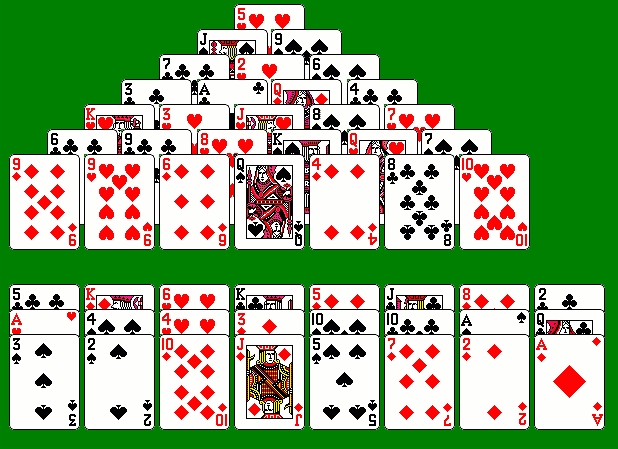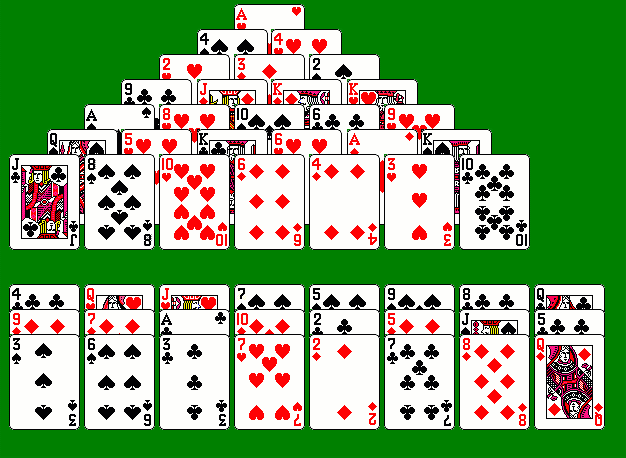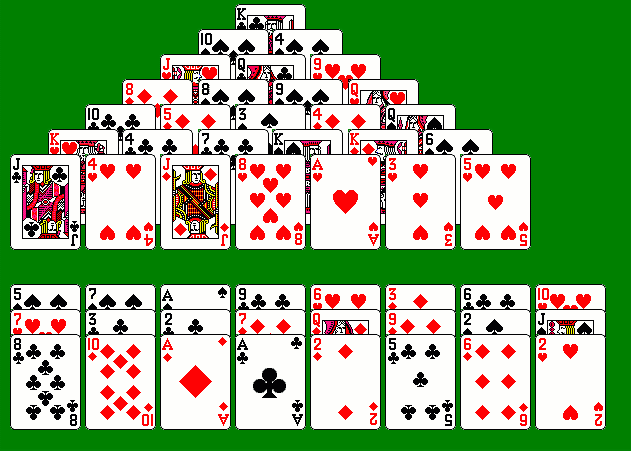
This is a legacy article to avoid broken links. A revised version is part of the Pyramid article here. The specific section on Giza is here.
Giza -- a solitaire based on Pyramid -- by Michael Keller
One of the more popular forms of card solitaire is Pyramid, in
which 28 cards are dealt from a single deck in the form of a triangle of overlapping rows
(see the picture below). In the standard form of the game, the remainder of the stock is
then dealt one card at a time, and available cards are discarded in pairs adding to 13
(kings are discarded alone; any available queen may be discarded with any available ace,
jack with two, ten with three, etc.). Stock cards which are not discarded when turned up
are placed on the top of a waste pile. Cards available for discarding are any uncovered
cards in the pyramid, the top of the waste, and the stock card most recently dealt.
There are a number of variants of the game, including a version where the waste may be
turned over to form a new stock and redealt twice more (with a scoring system devised by
Albert Morehead and Geoffrey Mott-Smith, who called their variant Par Pyramid).
Several variants allow the stock to be dealt into multiple waste piles, or add a reserve
of seven cards below the main pyramid. All of these modifications are intended to make the
game easier to win (the standard game has a win rate perhaps as low as 1 in 200), by
making more cards available more quickly.
With these variants in mind, I had the idea around 1996 to turn Pyramid into a completely open
solitaire (one in which all of the cards are dealt face up at the start of the game) like FreeCell; such games are usually very skillful and puzzle-like. I
tried a number of different tableaux; my original idea was four rows of six cards each
below the pyramid, but this blocked too frequently. I also originally tried an
upside-down pyramid, but the need to uncover the first few cards dominates the game and
the latter part of the game is anticlimactic. Experimentation proved that three rows of
eight cards (as in the picture below) worked best. I called the game Giza, after
the location of the great Egyptian pyramid. Several hundred games
suggest that
the win rate is at least 1 in 3 with careful play, although many of the
wins are very
difficult and 1 in 4 is a reasonable goal. I wrote a computer
version in 1997, and
the game was first published in 1998. Other computer versions of
the game for Windows can be found in Boris Sandberg's package BVS
Solitaire Collection, Thomas Warfield's Pretty Good
Solitaire, and Michael McCulloch's Solitaire
Plus.
Here are some difficult Giza problems I have found to date; the first is number 2112 in Solitaire Virtuoso. Any uncovered king, or any two uncovered cards adding to 13, may be removed (e.g. the four of diamonds may be removed along with either the nine of diamonds or the nine of hearts). A card may not be removed along with a card it is covering (the queen of clubs cannot be removed along with the ace of diamonds). Can you discard all 52 cards?

Here is number 15849 (solution):

And here is number 50832 (solution):

This article is copyright ©1999-2021 by Michael Keller. All rights reserved. This file was revised on August 26, 2011. Links to a longer article were added April 23, 2021.